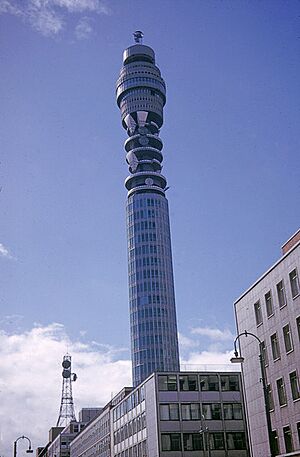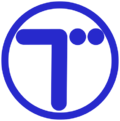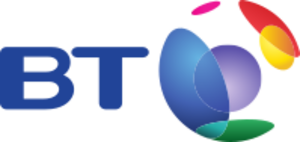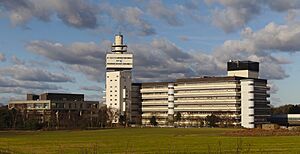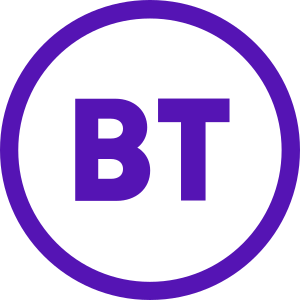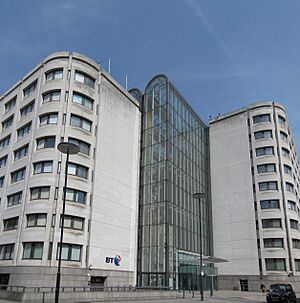BT Group facts for kids
 |
|
|
Formerly
|
British Telecom |
|---|---|
| Public | |
| Traded as |
|
| Industry | Telecommunications |
| Predecessor |
|
| Founded | 18 June 1846 (foundation of the Electric Telegraph Company) 1 January 1912 (National Telephone Company system take-over under the General Post Office) 1 October 1969 (as a public corporation under the Post Office) 1 October 1981 (as a public corporation under the British Telecom brand) 1 April 1984 (as a private company) |
| Headquarters |
,
England, UK
|
|
Area served
|
Worldwide |
|
Key people
|
|
| Products |
|
| Revenue | |
|
Operating income
|
|
| Total assets | |
| Owner |
|
|
Number of employees
|
98,800 (2023) |
| Divisions |
|
| Subsidiaries |
|
BT Group plc (trading as BT and formerly British Telecom) is a British multinational telecommunications holding company headquartered in London, England. It has operations in around 180 countries and is the largest provider of fixed-line, broadband and mobile services in the UK, and also provides subscription television and IT services.
BT's origins date back to the founding in 1846 of the Electric Telegraph Company, the world's first public telegraph company, which developed a nationwide communications network. BT Group as it came to be started in 1912, when the General Post Office, a government department, took over the system of the National Telephone Company becoming the monopoly telecoms supplier in the United Kingdom. The Post Office Act of 1969 led to the GPO becoming a public corporation, Post Office Telecommunications. The British Telecom brand was introduced in 1980, and became independent of the Post Office in 1981, officially trading under the name. British Telecom was privatised in 1984, becoming British Telecommunications plc, with some 50 percent of its shares sold to investors. The Government sold its remaining stake in further share sales in 1991 and 1993. BT holds a royal warrant and has a primary listing on the London Stock Exchange, and is a constituent of the FTSE 100 Index.
BT controls a number of large subsidiaries. Its BT Enterprise division supplies telecoms services to corporate and government customers worldwide, and its BT Consumer division supplies telephony, broadband, and subscription television services in the United Kingdom to around 18 million customers.
History
Electrical telegraphy
A number of privately owned electrical telegraph companies operated in the United Kingdom of Great Britain and Ireland from 1846 onwards. Among them were:
- Electric Telegraph Company, the world's first public telegraph company, which developed a nationwide communications network
- British and Irish Magnetic Telegraph Company
- British Telegraph Company
- London District Telegraph Company
- United Kingdom Telegraph Company
General Post Office
The Telegraph Act 1868 passed the control of all these to the Postal Telegraphs Department of the newly formed General Post Office (GPO). The Telegraph Act 1869 granted the GPO a monopoly over communications.
With the invention of the telephone by Alexander Graham Bell in 1876 the GPO began to provide telephone services from some of its telegraph exchanges. It was confirmed in 1880 that the 1869 Act included telephony even though the telephone had not been invented when the Act was first conceived. In 1882, the Postmaster-General, Henry Fawcett started to issue licences to operate a telephone service to private businesses and the telephone system grew under the GPO in some areas and private ownership in others. The GPO's main competitor, the National Telephone Company (NTC), emerged in this market by absorbing other private telephone companies. It controlled most of telephony in Britain before the 1880 ruling on the Telegraph Act 1869 mandated a nationalised service – which was instated in 1911 prior to the absorption of the NTC into the GPO in 1912.
The trunk network was unified under GPO control in 1896 and the local distribution network in 1912. A few municipally owned services remained outside of GPO control. These were Kingston upon Hull, Portsmouth and Guernsey. Hull still retains an independent operator, Kingston Communications, though it is no longer municipally controlled.
The assets of the National Telephone Company were acquired by the UK Government to form Post Office Telephones in late 1911.
Post Office engineers in the inter-war period had considerable expertise in both telecommunications and hearing assistive devices.
Although transistors were invented by Bell Telephone Laboratories in the US in 1948, it was not until the mid 1960s that a transistorised oscillator was introduced to make the calling sound on a telephone in the UK.
Post Office Telecommunications
In 1969 the GPO, a government department, became the Post Office, a nationalised industry separate from government. Post Office Telecommunications was set up as a division of the Post Office, in October 1969. The Post Office Act 1969 was passed to provide for greater efficiency in post and telephone services; rather than run a range of services, each organisation would be able to focus on their respective service, with dedicated management. By law, the Post Office retained the exclusive right to operate the UK national telecom network, (although since 1914 had licensed Hull City Council to operate its own local telephone network, Kingston Communications).
The 1970s was a period of great expansion for the Post Office. Most exchanges were modernised and expanded, and many services, such as STD and international dialling were extended. By the early 1970s, subscribers in most cities could dial direct to Western Europe, the US, and Canada; by the end of the decade, most of the world could be dialled direct. The System X digital switching platform was developed, and the first digital exchanges began to be installed. The Post Office also procured their own fleet of vans, based on the Commer FC model.
Post Office Telecommunications researched and implemented data communications using packet switching in the 1970s, resulting in the EPSS, International Packet Switched Service, and Packet Switch Stream.
British Telecom
In 1979 the Conservatives decided that telecommunications should be fully separated from the Post Office. The British Telecom brand was introduced in 1980. On 1 October 1981, this became the official name of Post Office Telecommunications, which became a state-owned corporation independent of the Post Office under the provisions of the British Telecommunications Act 1981. In 1982 BT's monopoly on telecommunications was broken with the granting of a licence to Mercury Communications.
Privatisation
On 19 July 1982, the Government announced its intention to sell shares in British Telecom to the public. On 1 April 1984, British Telecommunications was incorporated as a public limited company (plc) in anticipation of the passing of the Telecommunications Bill. This Bill received royal assent on 12 April as the Telecommunications Act 1984, and the transfer to British Telecommunications plc from British Telecom as a statutory corporation of its business, its property, its rights and liabilities took place on 6 August 1984. The remainder of the statutory corporation British Telecom was dissolved in 1994.
Initially all shares in the new plc were owned by the Government. In November 1984, 50.2% of the new company was offered for sale to the public and employees. Shares were listed in London, New York, and Toronto and the first day of trading on was 3 December 1984. The Government sold half its remaining interest in December 1991 and the other half in July 1993. In July 1997, the new Labour Government relinquished its Special Share ("Golden Share"), retained at the time of the flotation, which had effectively given it the power to block a takeover of the company, and to appoint two non-executive directors to the Board.
The company changed its trading name to "BT" on 2 April 1991. In 1996 Peter Bonfield was appointed CEO and chairman of the executive committee, promising a "rollercoaster ride".
In the 1990s, BT entered the Irish telecommunications market through a joint venture with the Electricity Supply Board, the Irish state owned power provider. This venture, entitled Ocean, found its main success through the launch of Ireland's first subscription-free dial-up ISP, oceanfree.net. As a telecoms company it found much less success, mainly targeting corporate customers. BT acquired 100% of this venture in 1999.
Over the period 1980 to 2000, BT and other providers adopted Internet product strategies when it became commercially advantageous.
Attempted global alliances
MCI
In June 1994 BT and MCI Communications launched Concert Communications Services which was a $1 billion joint venture between the two companies. Its aim was to build a network which would provide easy global connectivity to multinational corporations.
This alliance progressed further on 3 November 1996 when the two companies announced that they had agreed to a merger, creating a global telecommunications company called Concert plc. The proposal gained approval from the European Commission, the US Department of Justice, and the US Federal Communications Commission and looked set to proceed.
However, in light of pressure from investors reacting to the slide in BT's share price on the London Stock Exchange, BT reduced its bid price for MCI, releasing MCI from its exclusivity clause and allowing it to speak to other interested parties. On 1 October 1997, Worldcom made a rival bid for MCI which was followed by a counter-bid from GTE.
BT sold its stake in MCI to Worldcom in 1998 for £4,159 million. As part of the deal, BT also bought out from MCI its 24.9% interest in Concert Communications, thereby making Concert a wholly owned part of BT.
The reaction to the failure of the deal in the City of London was critical of then Chairman Iain Vallance and CEO Peter Bonfield, and the lack of confidence from the failed merger led to their removal.
AT&T
As BT owned Concert in 1994, and still wanted access to the North American market, it needed a new partner. An AT&T/BT option had been mooted in the past, but stopped on regulatory grounds due to their individual virtual monopolies in their home markets. By 1996, this had receded to the point where a deal was possible, and a deal was consummated in 1998.
At its height, the Concert managed network was extensive. Although Concert continued signing customers, its rate of revenue growth slowed, so that in 1999 David Dorman was made CEO with a brief to revive it.
In late 2000 the BT and AT&T boards fell-out, partly due to each partner's excess debt and the resulting board room clear-outs, partly due to Concert's extensive annual losses. AT&T recognized that Concert was a threat to its ambitions if left intact, and so negotiated a deal where Concert was split in two in 2001: North America and Eastern Asia went to AT&T, the rest of the world and $400M to BT. BT's remaining Concert assets were merged into its BT Ignite, later BT Global Services group.
BT Ireland
In 2000, BT acquired Esat Telecom Group plc, and all its subsidiary companies, and Ireland On Line. It also purchased Telenor's minority shareholding in Esat Digifone. The Esat Telecom Group was split in two with the landline and internet operations were combining with Ocean to become part of BT Ignite. Esat Group was renamed Esat BT in July 2002, and eventually BT Ireland in April 2005. Esat Digifone became part of BT Wireless, before being spun off into a separate independent company mmo2 plc (now Telefónica Europe). EsatBT installed the first DSL lines in Ireland, to try and compete heavily with former state telecoms company Eircom and operate one exchange, in Limerick.
2001 debt crisis and sale, demerger
By 2001, BT had a debt of £30 billion, much of which was acquired during the bidding round for the 3rd generation mobile telephony (commonly known as 3G) licences. It had also failed in its series of proposed global mergers, and the funds flowing from its then virtual monopoly of the UK market place had been largely removed. It was also headed by two executives who had little support from the London Stock Exchange, particularly in light of a 60% drop in share price in sixteen months.
Philip Hampton joined as CFO, and in April 2001 Sir Iain Vallance was replaced as chairman by recognised turn around expert Sir Christopher Bland.
In May 2001 BT carried out corporate Europe's largest ever rights issue, allowing it to raise £5.9 billion. A few days before, it sold stakes in Japan Telecom, in mobile operator J-Phone Communications, and in Airtel of India to Vodafone.
In June 2001 BT's directory business was sold as Yell Group to a combination of private equity firms Apax Partners and Hicks, Muse, Tate & Furst for £2.1 billion.
A demerger followed in November 2001, when the former mobile telecommunications business of BT, BT Cellnet, was hived off as a separate business named "mmO2". This included BT owned or operated networks in other countries, including BT Cellnet (UK), Esat Digifone (Ireland), and Viag Interkom (Germany). All networks now owned or operated by mmO2 (except Manx Telecom) were renamed as O2. The de-merger was accomplished via a share-swap, all British Telecommunications plc shareholders received one mmO2 plc and one BT Group plc (of which British Telecommunications is now a wholly owned subsidiary) share for each share they owned. British Telecommunications plc was de-listed on 16 November, and the two new companies started trading on 19 November.
Aftermath, 2001–2006
At the end of the series of sales, in October 2001 Sir Peter Bonfield resigned, and was replaced by former Lucent CEO Ben Verwaayen.
During Bonfield's tenure the share price went from £4 to £15, and back again to £5. Bonfield's salary to 31 March 2001 was a basic of £780,000 (increasing to £820,000) plus a £481,000 bonus and £50,000 of other benefits including pension. He also received a deferred bonus, payable in shares three years' later, of £481,000, and additional bonuses of £3.3 million.
mmO2 plc was replaced by O2 plc in a further share-swap in 2005, and subsequently bought in an agreed takeover by Telefónica for £18 billion and delisted. In 2004, BT launched Consult 21, a consultation organisation that was to aid BT 21CN in the eventual conversion to digital telephony.
In 2004, BT was awarded the contract to deliver and manage N3, a secure and fast broadband network for the NHS National Programme for IT (NPfIT) program, on behalf of the English National Health Service (NHS).
In 2005 BT made a number of acquisitions. In February 2005, BT acquired Infonet (now re-branded BT Infonet), a large telecoms company based in El Segundo, California, giving BT access to new geographies. It also acquired the Italian company Albacom. Then in April 2005, it bought Radianz from Reuters (now rebranded as BT Radianz), which expanded BT's coverage and provided BT with more buying power in certain countries.
In August 2006, BT acquired online electrical retailer Dabs.com for £30.6 million. The BT Home Hub manufactured by Inventel was also launched in June 2006.
In October 2006, BT confirmed that it would be investing 75% of its total capital spending, put at £10 billion over five years, in its new Internet Protocol (IP) based 21st century network (21CN). Annual savings of £1 billion per annum were expected when the transition to the new network was to have been completed in 2010, with over 50% of its customers to have been transferred by 2008. That month the first customers on to 21CN was successfully tested at Adastral Park in Suffolk.
2007 to 2012
In January 2007, BT acquired Sheffield-based ISP, PlusNet plc, adding 200,000 customers. BT stated that PlusNet will continue to operate separately out of its Sheffield head-office. On 1 February 2007, BT announced agreed terms to acquire International Network Services Inc. (INS), an international provider of IT consultancy and software.
In February 2007, Sir Michael Rake succeeded Sir Christopher Bland. In April that year, they acquired COMSAT International, followed in October by the acquisition of Lynx Technology.
BT acquired Wire One Communications in June 2008 and folded the company into "BT Conferencing", its existing conferencing unit, as a new video business unit In July 2008, BT acquired the online business directory firm Ufindus for £20 million in order to expand its position in the local information market in GB. On 28 July 2008, BT acquired Ribbit, of Mountain View, California, "Silicon Valley's First Phone Company". Ribbit provides Adobe Flash/Flex APIs, allowing web developers to incorporate telephony features into their software as a service (SaaS) applications.
In the early days of its fibre broadband rollout, BT said it would deliver fibre-to-the-premises (FTTP) to around 25% of the Country, with the rest catered for by the slower fibre-to-the-cabinet (FTTC), which uses copper wiring to deliver the final stretch of the connection. In 2014, with less than 0.7% of the company's fibre network being FTTP, BT dropped the 25% target, saying that it was "far less relevant today" because of improvements made to the headline speed of FTTC, which had doubled to 80 Mbit/s since its fibre broadband rollout was first announced. To supplement FTTC, BT offered an 'FTTP on Demand' product. In January 2015, BT stopped taking orders for the on-demand product.
On 1 April 2009, BT Engage IT was created from the merger of two previous BT acquisitions, Lynx Technology and Basilica. Apart from the name change not much else changed in operations for another 12 months. On 14 May 2009, BT said it was cutting up to 15,000 jobs in the coming year after it announced its results for the year to 31 March 2009. Then in July 2009, BT offered workers a long holiday for an up front sum of 25% of their annual wage or a one-off payment of £1000 if they agree to go part-time.
On 6 April 2011, BT launched the first online not-for-profit fundraising service for UK charities called BT MyDonate as part of its investment to the community. The service will pass on 100% of all donations made through the site to the charity, and unlike other services which take a proportion as commission and charge charities for using their services, BT will only pass on credit/debit card charges for each donation. The service allows people to register to give money to charity or collect fundraising donations. BT developed MyDonate with the support of Cancer Research UK, Changing Faces, KidsOut, NSPCC and Women's Aid.
2013 to 2020
In March 2013, BT was allocated 4G spectrum in the UK following an auction and assignment by Ofcom, after paying £201.5m.
On 1 August 2013, BT launched its first television channels, BT Sport, to compete with rival broadcaster Sky Sports. Plans for the channels' launch came about when it was announced in June 2012 that BT had been awarded a package of broadcast rights for the Premier League from the 2013–14 to 2015–16 season, broadcasting 38 matches from each season. In February 2013, BT acquired ESPN Inc.'s UK and Ireland TV channels, continuing its expansion into sports broadcasting. ESPN America and ESPN Classic were both closed, while ESPN continued to be operated by BT. On 9 November 2013, BT announced it had acquired exclusive rights to the Champions League and Europa League for £897m, from the 2015 season, with some free games remaining including both finals.
On 1 November 2014, BT created a new central business services organisation to provide customer services and improve operational efficiency.
On 24 November 2014, shares in BT rose considerably on the announcement that the company was in talks to buy back O2, while at the same time confirmed it was also in talks to acquire EE. BT subsequently entered into exclusive talks to buy EE for £12.5 billion on 15 December 2014 and confirmed on 5 February 2015, subject to regulatory approval. The deal combined BT's 10 million retail customers and EE's 24.5 million direct mobile subscribers. Deutsche Telekom would own 12% of BT, while Orange S.A. would own 4%.
In March 2015, BT launched a 4G service as BT Mobile BT Group CEO Gavin Patterson announced that BT plans to migrate all of its customers onto the IP network by 2025, switching off the company's ISDN network.
On 15 January 2016, BT received approval by the Competition and Markets Authority to acquire EE. The deal was officially completed on 29 January 2016 with Deutsche Telekom then owning 12% of BT, while Orange S.A. owned 4%.
On 1 February 2016, BT announced a new organisational structure to take effect from April 2016 after acquiring EE. The EE brand, network and high street stores became a second consumer division, operating alongside BT Consumer to serve customers with mobile services, broadband and TV and continued to deliver the Emergency Services Network contract awarded to EE in late 2015. There was to be a new BT Business and Public Sector division with around £5bn of revenues to serve small and large businesses as well as the public sector in the UK and Ireland. It was to comprise the existing BT Business division along with EE's business division and those parts of BT Global Services that are UK focused. There will also be another new division; BT Wholesale and Ventures that will comprise the existing BT Wholesale division along with EE's MVNO business as well as some specialist businesses such as Fleet, Payphones and Directories. Gerry McQuade, Chief Sales and Marketing Officer, Business at EE, was to be its CEO. The June 2016 United Kingdom European Union membership referendum set off the Brexit process.
On 8 June 2017, BT appointed KPMG as its new auditor to replace PwC in the wake of a fraud scandal in Italy that triggered a major profit warning earlier that year. Also in of that year, KPMG fired six US employees over a scandal that calls into question efforts to ensure that public company accounts are being properly scrutinised.
On 8 July 2017, The Daily Telegraph reported that BT "has called in consultants from McKinsey to conduct a review of its businesses in the hope of saving hundreds of millions of pounds per year. The work, dubbed 'Project Novator', is understood to include a potential merger of BT's struggling global services corporate networking and IT unit with its business and public sector division". On 28 July 2017, BT again announced organisational changes to "simplify its operating model, strengthen accountabilities and accelerate its transformation" to bring together its BT Consumer and EE divisions into a new unified BT Consumer division to operate across three brands – BT, EE and Plusnet. It was to take effect from 1 April 2018.
On 18 April 2018, BT announced further organisational changes after unification of BT Consumer and EE divisions, bringing together its BT Business and Public Sector and BT Wholesale and Ventures divisions into a new unified division known as BT Enterprise. It was to include BT's Ventures business which "acts as an incubator for potential new growth areas of the company" and to report as a single unit from 1 October 2018.
2020–present
In June 2021, the French telecommunications company, Altice acquired a 12% stake in BT, increasing it to 18% in December 2021 and 24.5% in May 2023. Patrick Drahi's purchase of 650 million shares cost about £960 million. Altice's increasing ownership in BT Group posed questions around the national security of the United Kingdoms infrastructure asset and the UK government opened an investigation in May 2022 to look into possible security implications of Patrick Drahi and Altice's ownership. In August 2022 the Government concluded its investigation and Patrick Drahi would not be forced to cut his stake in BT after the UK government ruled the investment did not pose any national security concerns.
In July 2023, BT announced the appointment of businesswoman Allison Kirkby as its new Chief Executive, replacing Philip Jansen by January 2024.
At the end of 2023, BT Group announced it uses Broadpeak technology for its Multicast-Assisted Unicast Delivery (MAUD) technology.
Operations
BT Group is a holding company; the majority of its businesses and assets are held by its wholly owned subsidiary British Telecommunications plc. BT's businesses are operated under special government regulation by the British telecoms regulator Ofcom (formerly Oftel). BT has been found to have significant market power in some markets following market reviews by Ofcom. In these markets, BT is required to comply with additional obligations such as meeting reasonable requests to supply services and not to discriminate.
BT runs the telephone exchanges, trunk network and local loop connections for the vast majority of British fixed-line telephones. Currently BT is responsible for approximately 28 million telephone lines in GB. Apart from KCOM Group, which serves Kingston upon Hull, BT is the only UK telecoms operator to have a Universal service Obligation, (USO) which means it must provide a fixed telephone line to any address in the UK. It is also obliged to provide public call boxes.
As well as continuing to provide service in those traditional areas in which BT has an obligation to provide services or is closely regulated, BT has expanded into more profitable products and services where there is less regulation. These are principally, broadband internet service and bespoke solutions in telecommunications and information technology.
Branding
In 2019, a simplified BT logo and brand was launched to replace the previous mutli-coloured globe logo. In April 2022, BT announced its intentions to focus on the EE brand for consumer products.
Corporate affairs
Buildings and facilities
As BT operates in around 180 countries, it owns and leases a range of buildings and facilities in the UK and around the world. In 2001, it sold some of its UK property portfolio for £2.38 billion to Telereal Trillium in a 30-year leaseback. The deal included 6,700 properties and contributed towards alleviating its debt at the time, with the main advantage being flexibility as it allows BT to vacate property over time, so as to adapt to changing operational requirements.
Headquarters
Until December 2021, BT Group's world headquarters and registered office was the BT Centre, a 10-storey office building at 81 Newgate Street in the City of London, opposite St Paul's tube station. In November 2021 BT relocated to new headquarters at One Braham, a brand new 18-storey building completed earlier in 2021. In March 2024, BT Group opened a new multi-million-pound hub and Welsh headquarters in Cardiff for 1,000 BT Group employees.
Buildings and stations
Some of its UK buildings and stations are:
- Adastral Park – headquarters of BT Labs in Suffolk
- The Assembly – building in Bristol
- Baynard House – building in City of London
- BT Riverside Tower – headquarters of BT Northern Ireland in Belfast
- BT Tower – building in Swansea
- Goonhilly Satellite Earth Station – satellite earth station in Cornwall
- Guardian telephone exchange – telephone exchange in Manchester
- Madley Communications Centre – satellite earth station in Herefordshire
- National Network Management Centre – network operations centre in Shropshire
- Stadium House – building in Cardiff
Telecommunications towers
BT remains one of the largest owners of telecommunications towers in the UK and were a major node in its microwave network. Its BT Tower in London is notable for numerous reasons such as being the tallest building in the UK from its construction in the 1960s until the early 1980s, its revolving restaurant at the top known as 'Top of the Tower' in operation through the late 1960s and 1970s, and remains one of the UK's most important communications nerve centres, the heart of a vast broadcasting and communications network. It carries approximately 95% of the UK's TV content, including live broadcasts and 99% of all live football games as well as pioneering the first international HD, 3D and 4K television transmissions. It serves media production and distribution customers around the world and as part of the Things Connected Network launched in London, it became the highest building in the world to host an Internet of things (IoT) base station in September 2016. Some of its towers are:
- BT Tower in London
- BT Tower in Birmingham
- Charwelton BT Tower in Northamptonshire
- Heaton Park BT Tower in Manchester
- Morborne Hill BT Tower in Cambridgeshire
- Purdown BT Tower in Bristol
- Pye Green BT Tower in Staffordshire
- Stokenchurch BT Tower in Buckinghamshire
- Sutton Common BT Tower in Cheshire
- Tinshill BT Tower in West Yorkshire
- Tolsford Hill BT Tower in Kent
- Turners Hill BT Tower in West Midlands
- Wotton-under-Edge BT Tower in Gloucestershire
- Zouches Farm in Bedfordshire
Other
Some of its other UK facilities are:
- Red telephone box – original telephone boxes
- KX telephone boxes – successor to the red telephone boxes
- LinkUK – modern kiosks replacing existing telephone boxes with a range of free services
- TAT-14 – 14th consortium transatlantic telecommunications cable system
Divisions
BT Group is organised into the following divisions:
Customer facing
- BT Consumer – provides retail telecoms services to consumers in the UK including:
- BT Broadband
- EE Broadband
- EE Mobile
- EE TV
- EE WiFi
- Plusnet – internet service provider, provides mobile and fixed communications services to consumers in the UK
- TNT Sports (joint venture, operated by Warner Bros. Discovery)
- BT Business – products and services to organisations in the small-to-medium-sized business, corporate and public sectors in the UK and globally, and wholesale services. Formed from the merger of BT Enterprise and BT Global Services.
- Openreach – fenced-off wholesale division, established in 2005 following a review by Ofcom and commenced operations in 2006, employing 25,000 engineers previously employed by BT. Its purpose is to ensure that other communications providers have the same operational conditions as BT, and is responsible for the provision and repair in the "last mile" of copper wire.
Internal services
- Networks – Responsible for designing, building and running the networks and technology platforms that BT and its customers use.
- BT Research
- Digital – Responsible for leading BT's digital transformation, driving experience innovation and delivering the products and services customers use.
- BT's procurement arm, "BT Sourced", was established in February 2021 and is based in Dublin.
Corporate governance
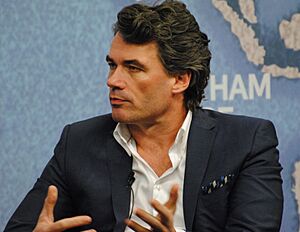
BT's board of directors as of November 2021:
- Jan du Plessis – Chairman
- Philip Jansen – Chief Executive
- Adel Al-Saleh – Non-independent, non-executive director
- Sir Ian Cheshire – Independent non-executive director
- Sabine Chalmers – Company secretary &general counsel
- Adam Crozier – Chairman Designate
- Iain Conn – Senior Independent Director & Non-executive director
- Simon Lowth – Group Chief Financial Officer
- Isabel Hudson – Non-executive director
- Matthew Key – Non-executive director
- Allison Kirkby – Non-executive director and CEO-designate
- Leena Nair – Non-executive director
- Sara Weller– Non-executive director
BT's executive committee as of March 2018:
- Philip Jansen – Chief Executive
- Simon Lowth – Group Chief Financial Officer
- Marc Allera – CEO of BT Consumer
- Bas Burger – CEO of BT Global Services
- Sabine Chalmers – General counsel
- Gerry McQuade – CEO of BT Enterprise (BT Business and Public Sector and BT Wholesale and Ventures)
- Ed Petter – Corporate affairs director
- Cathryn Ross – Director of regulatory affairs
- Michael Sherman – Chief strategy and transformation officer
- Howard Watson – Chief technology and information officer (CTIO) of BT Technology, Service & Operations
- Alison Wilcox – HR director
- Dan Fitz – Company secretary
- Clive Selley – CEO of Openreach
Pension fund
BT has the second largest defined benefit pension plan of any UK public company. The trustees valued the scheme at £36.7 billion at the end of 2010; an actuarial valuation valued the deficit of the scheme at £9.043 billion as of 31 December 2008. Following a change in the regulations governing inflation index linking, the deficit was estimated at £5.2 billion in November 2010.
Sponsorships
BT sponsored Scotland's domestic rugby union championship and cup competitions between 1999 and 2006.
On 31 July 2012, it was announced that BT agreed a three-year sponsorship deal with Ulster Rugby and sees BT become the Official Communications Partner. BT's logo will appear on the Ulster Rugby shirt sleeve for all friendlies, Heineken Cup and RaboDirect Pro12 matches as well as a significant brand presence at their home ground; Ravenhill Stadium.
On 29 July 2013, it was announced that BT had partnered up with Scottish Rugby Union in a four-year sponsorship deal with its two professional clubs; Edinburgh Rugby and Glasgow Warriors that will commence from August 2013. The deal involves BT Sport becoming the new shirt sponsor for both clubs as well as being promoted with BT Group at their respective home grounds; Scotstoun Stadium and Murrayfield Stadium.
On 13 May 2014, BT joined Sky, TalkTalk and Virgin Media as founding partners of Internet Matters, a not-for-profit organisation that provides online safety advice for parents and their children.
On 28 May 2014, it was announced that BT agreed a £20 million four-year sponsorship deal with Scottish Rugby Union which includes BT securing the naming rights for Murrayfield Stadium which becomes BT Murrayfield Stadium, become sponsor of the Scotland sevens team, become principal and exclusive sponsor of Scotland's domestic league and cup competitions from next season, taking over the role from The Royal Bank of Scotland and become sponsor of Scottish Rugby's four new academies that aims to drive forward standards for young players who have aspirations to play professionally.
On 14 April 2015, it was announced that as part of BT's current £20 million four-year sponsorship deal with Scottish Rugby Union that was announced in May 2014, BT has completed its sponsorship portfolio following an additional investment of £3.6 million for the 3 years remaining of its sponsorship deal, to become the new shirt sponsor for the Scotland national teams.
On 27 January 2016, it was announced that BT, alongside YouTube will be the new joint headline sponsors in a three-year deal with Edinburgh International Television Festival. The two companies will "share prominence across all branding of the 41st TV Festival, including the famous MacTaggart Lecture and will work closely with the festival organisers in their bid to reflect new trends in a rapidly transforming industry, from new ways of distributing content to technical innovations such as virtual reality".
BT is the founding and principal partner of the Wayne Rooney Foundation, which was established to improve the lives of children and young people. The Foundation will run events "to raise vital funds to support the work of key organisations dedicated to supporting disadvantaged and vulnerable children and young people". These organisations are four chosen charities which are, Manchester United Foundation, NSPCC, Claire House Children's Hospice and Alder Hey Children's Hospital. The first of these events was Wayne's testimonial match in August 2016 between Manchester United F.C. and Everton F.C. which raised £1.2 million. The match was screened live through BT Sport with BT MyDonate being the official fundraising platform for the testimonial, with both online and text options for donations promoted during the match.
On 26 May 2017, it was announced that BT is to sponsor the 2017 British Urban Film Festival (BUFF) and sees BT host every event of the film festival, including the Awards at the BT Tower. BT will also broadcast the awards ceremony on BT.com and will have the opportunity to screen films acquired from the festival on its BT TV store platform.
On 6 September 2017, it was announced that BT had extended its current £20 million four-year sponsorship deal with Scottish Rugby Union that was announced in May 2014, for a further three years beginning from June 2018. The new deal sees BT retain the naming rights to BT Murrayfield Stadium, alongside its role as principal partner of the Scotland national team and Scotland 7s. BT's logo will continue to be displayed on the front of Scotland rugby shirts across the world, in the Six Nations Championship, as well as the summer and autumn test matches. BT will also continue to be promoted at Edinburgh Rugby and Scotstoun Stadium in Glasgow.
Historical financial performance
BT's financial results have been as follows:
2008–present
| Year ending 31 March | 2008 | 2009 | 2010 | 2011 | 2012 | 2013 | 2014 | 2015 | 2016 | 2017 | 2018 | 2019 | 2020 | 2021 | 2022 | 2023 |
|---|---|---|---|---|---|---|---|---|---|---|---|---|---|---|---|---|
| Turnover (£m) | 20,704 | 21,390 | 20,911 | 20,076 | 19,307 | 18,017 | 18,287 | 17,851 | 18,909 | 24,082 | 23,746 | 23,428 | 22,905 | 21,370 | 20,845 | 20,669 |
| Profit/(loss) before tax (£m) | 1,976 | (134) | 1,007 | 1,717 | 2,421 | 2,501 | 2,827 | 3,172 | 3,473 | 2,354 | 2,616 | 2,666 | 2,353 | 1,804 | 1,963 | 2,290 |
| Net profit/(loss) (£m) | 1,738 | (81) | 1,029 | 1,504 | 2,003 | 2,091 | 2,018 | 2,135 | 2,588 | 1,908 | 2,032 | 2,159 | 1,734 | 1,472 | 1,274 | 1,905 |
| Basic eps (p) | 21.5 | 3.2 | 13.3 | 19.4 | 23.7 | 26.7 | 25.7 | 26.5 | 33.2 | 19.2 | 20.5 | 21.8 | 17.5 | 14.8 | 12.9 | 19.4 |
1992–2007
| Year ending 31 March | 1992 | 1993 | 1994 | 1995 | 1996 | 1997 | 1998 | 1999 | 2000 | 2001 | 2002 | 2003 | 2004 | 2005 | 2006 | 2007 |
|---|---|---|---|---|---|---|---|---|---|---|---|---|---|---|---|---|
| Turnover (£m) | 13,337 | 13,242 | 13,675 | 13,893 | 14,446 | 14,935 | 15,640 | 16,953 | 18,715 | 17,141 | 18,447 | 18,727 | 18,519 | 18,429 | 19,514 | 20,223 |
| Profit/(loss) before tax (£m) | 3,073 | 1,972 | 2,756 | 2,662 | 3,019 | 3,203 | 3,214 | 4,295 | 2,942 | (1,031) | 1,461 | 3,157 | 1,945 | 2,693 | 2,633 | 2,484 |
| Net profit/(loss) (£m) | 2,044 | 1,220 | 1,767 | 1,731 | 1,986 | 2,077 | 1,702 | 2,983 | 2,055 | (1,875) | 1,008 | 2,702 | 1,414 | 1,539 | 1,644 | 2,852 |
| Basic eps (p) | 33.2 | 19.8 | 28.5 | 27.8 | 31.6 | 32.8 | 26.6 | 46.3 | 31.7 | (25.8) | 12.1 | 31.4 | 16.4 | 18.1 | 19.5 | 34.4 |
Historical documents
Records of the Post Office Corporation (Telecommunications division) 1969–1981 and its predecessors (including Post Office Telegraph and Telephone Service 1864–1969 and some private telegraph and telephone companies) are Public Records, and are held by BT Archives.
See also
 In Spanish: BT Group para niños
In Spanish: BT Group para niños
- List of telephone operating companies
- UK telephone area codes (STD codes)


